Decoding Bitcoin Futures
In this article, we examine Bitcoin futures, their impact on market trends, and how metrics like open interest contribute to investment strategies. Gain actionable insights to make more informed trading decisions.
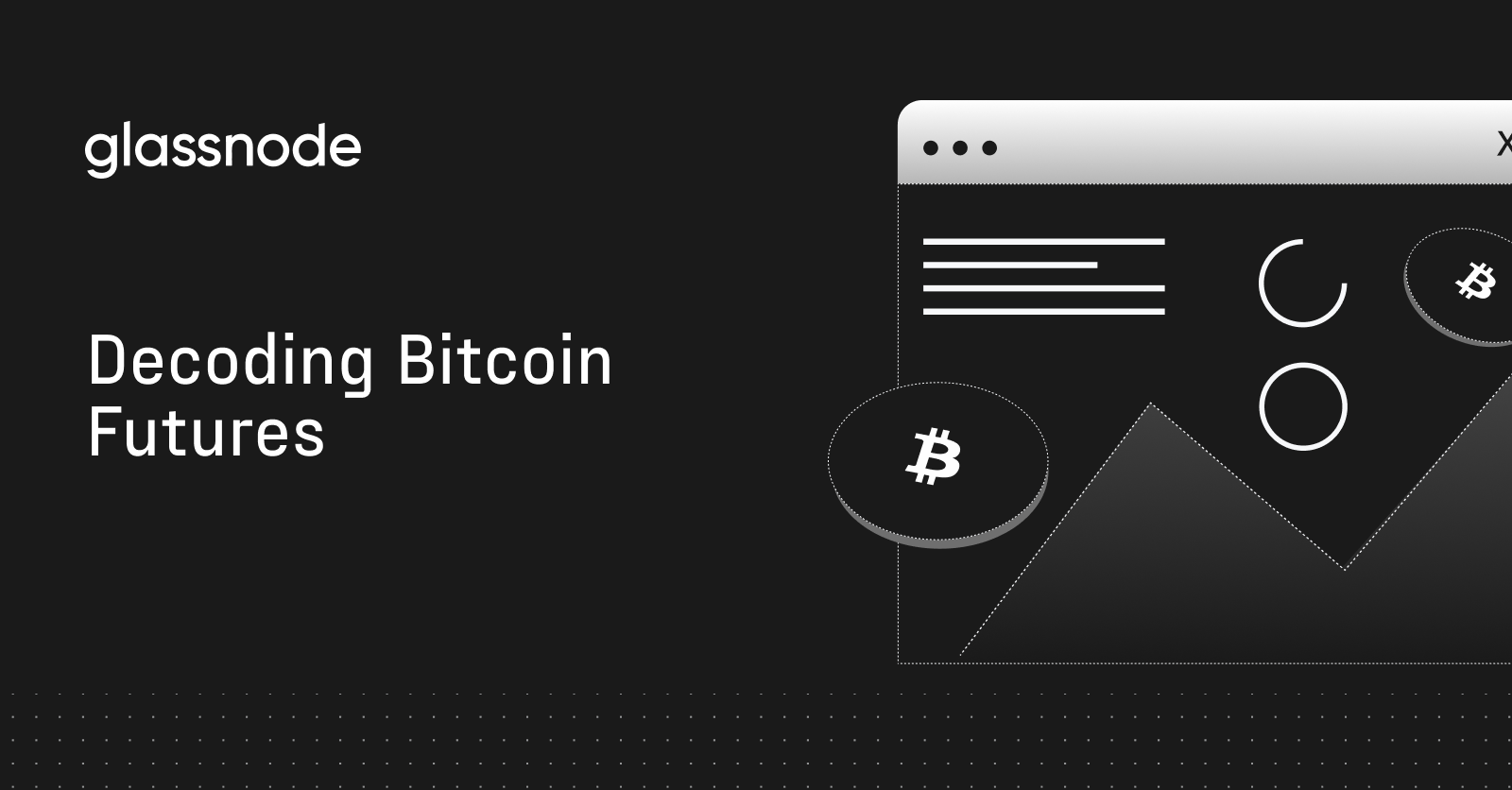
Disclaimer: The analysis provided here offers a window into the world of crypto derivatives and Bitcoin futures. Please remember that this represents just one element in the multifaceted realm of cryptocurrency. While data from Glassnode can provide valuable insights, it's essential to approach this information holistically, as the beginning of your personal research journey.
Looking back at Bitcoin's journey, a key event was the launch of futures trading by major financial exchanges, the Chicago Board Options Exchange (CBOE) and the Chicago Mercantile Exchange (CME), in December 2017. This moment, which represents a pivotal moment, had been building since 2016 when the idea of "perpetual swaps" first appeared and was later adopted by various crypto exchanges.
In simple terms, a future is a contract that requires someone to buy or sell an asset at a set price on a future date. These contracts are well-established in the world of finance and offer special ways to invest and manage risk, especially given the volatile nature of digital currencies.
Unraveling the Bitcoin Futures Landscape
The 2021 U.S. launch of the first Bitcoin futures ETF expanded market access by offering a legal framework for Bitcoin futures trading. These futures contracts enable both speculative gains on Bitcoin's price and risk management, without the need for direct ownership.
Unique Characteristics of Bitcoin Futures:
Bitcoin futures differ from traditional futures in several key ways. They have no costs of carry, operate around the clock, and can offer margins up to 100x on unregulated exchanges. These features contribute to both volatility and opportunity in the market.
Growing Popularity:
Building on these unique features, Bitcoin futures currently make up 49.18% (August 2023) of total cryptocurrency trading volume. This high percentage reflects increasing adoption among various market participants, from retail investors to financial institutions.
Analyzing The Numbers:
To better understand this surge in adoption, the Futures Volume metric below offers a snapshot of the market's evolution. The year 2023 has witnessed a 151% surge in Bitcoin futures trading volume for two key reasons:
- Signs of a Maturing Market: Despite the recent market volatility, certain characteristics of the Bitcoin market, such as the increase in futures trading, suggest traits of a maturing market.
- Increasing Role of Sophisticated Players: Increased futures trading volume suggests that traders and institutions are increasingly using these contracts in the crypto market.
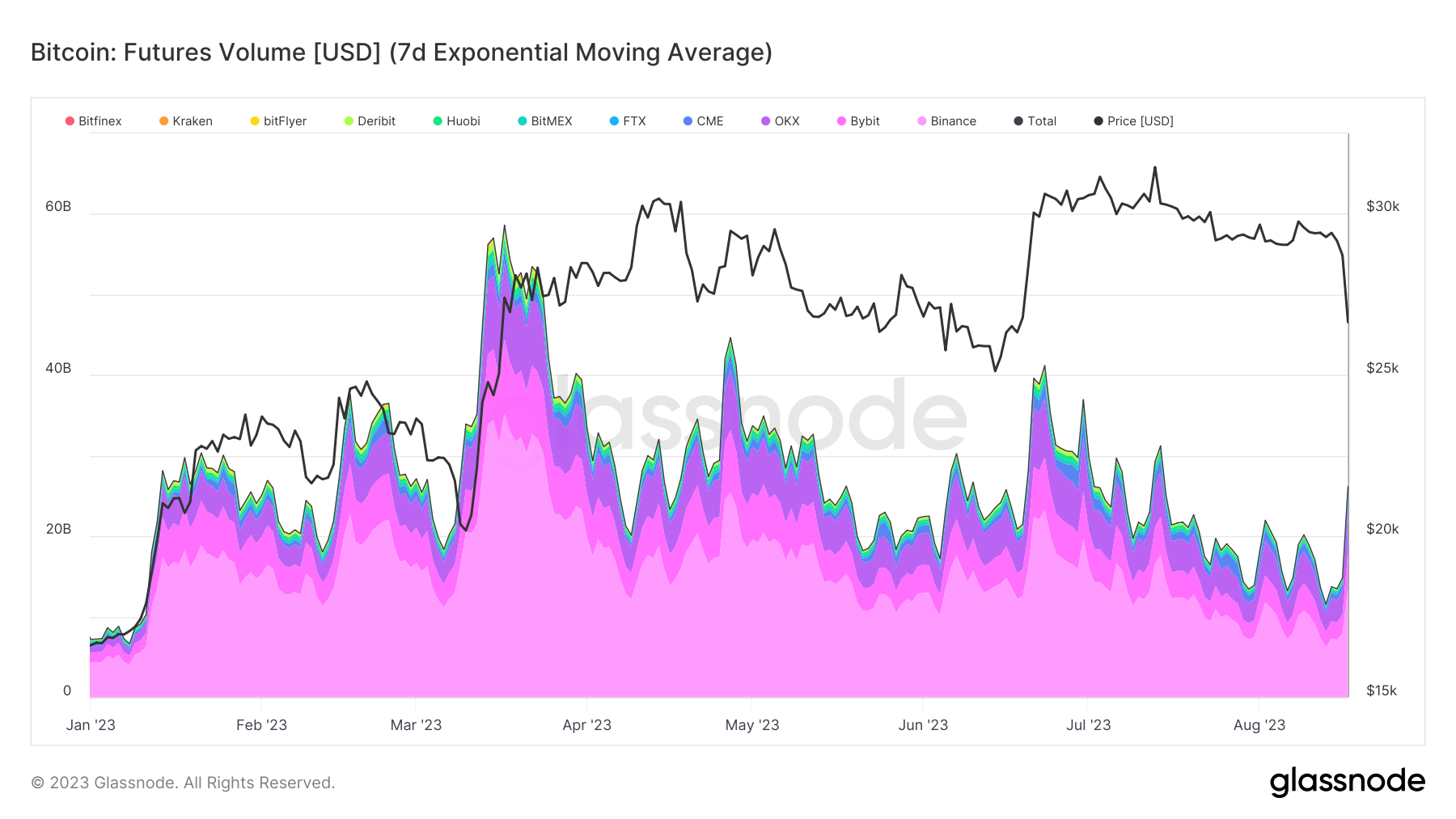
The Evolution of Bitcoin Futures
While volume and capitalization metrics are essential, they only tell part of the story. The real transformation in Bitcoin futures trading has been technological, resulting in shifts like the emergence of decentralized futures platforms and the integration of smart contracts.
The Rise of Decentralized Futures Platforms
One of the most groundbreaking developments has been the rise of decentralized platforms. These platforms offer peer-to-peer trading and negate the need for centralized intermediaries, thus democratizing access and altering the fundamental mechanics of transaction processes.
Smart Contracts:
Smart contracts have further enriched this landscape. These are not mere add-ons; they establish a framework for automating, streamlining, and rendering the trading process more transparent and secure. These self-executing contracts with predefined rules minimize human error and significantly reduce the role of middlemen.
Perpetual Contracts:
The innovations don't end here. The concept of perpetual contracts—those without an expiration date—adds another layer of flexibility and strategy to Bitcoin futures trading. Unlike traditional futures, which have fixed expiration dates, perpetual contracts offer continuous trading opportunities, thereby eliminating the need to keep an eye on contract rollovers.
The Role and Impact of Bitcoin Options in Crypto Derivatives Markets
Alongside futures, Bitcoin options have emerged as another crucial player. Functioning similarly to traditional options, they grant holders the right—but not the obligation—to buy or sell Bitcoin at a predetermined price, either on or before a specific date. So, why should you pay attention to Bitcoin options?
Significance of Bitcoin Options
To understand their significance, let's look back at 2022. During this year, as the provided Futures Volume chart reveals below, Bitcoin's price experienced remarkable volatility. Options played a considerable role in this, with contracts worth $3.7 billion expiring in January alone. But what happens when these contracts near their expiration?
Options Expiry and its Impact
The term "expiry" is pivotal to grasping the mechanics of options. When this predetermined date arrives, holders face a decision: either exercise the option at the pre-agreed price or let it expire worthless. This creates a sense of market anticipation that often shifts trading dynamics as the expiry date nears.
Tracking Expiry Dates
For traders eager to keep a pulse on these market-moving events, various crypto analytics platforms and derivative exchanges offer calendars or countdowns. Such tools are invaluable for gauging the expiry dates of significant options contracts. However, options and futures don't just operate in isolation; they have a ripple effect on the broader market.
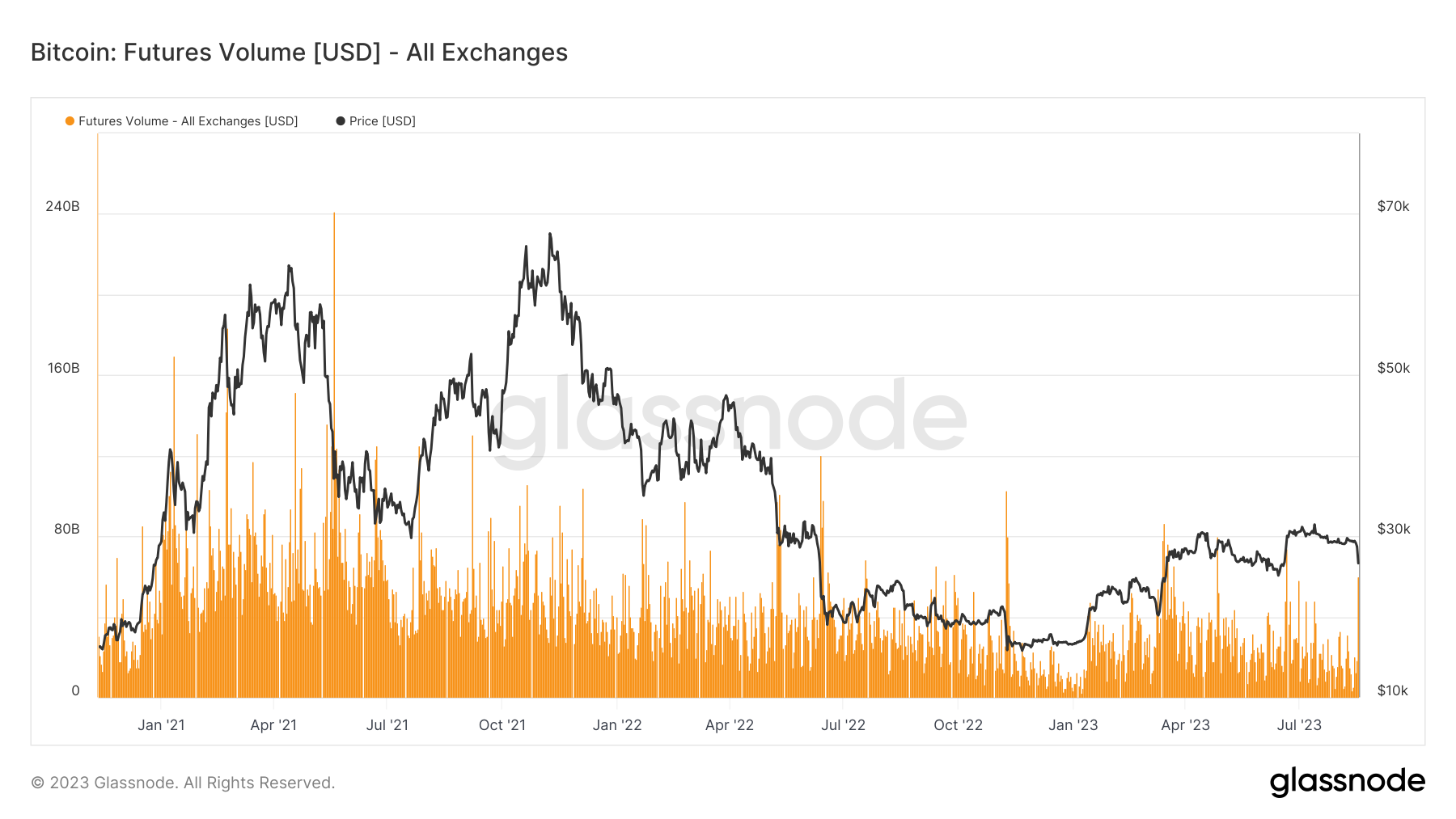
Understanding Liquidation Events in the Futures Market
But while futures and options offer trading opportunities, they also come with their own sets of risks and complexities, as evidenced by liquidation events. The term "liquidation event" refers to instances where a trader's futures position is forcibly closed due to insufficient margin. These events serve as crucial indicators of market stress, making them worthy of close scrutiny.
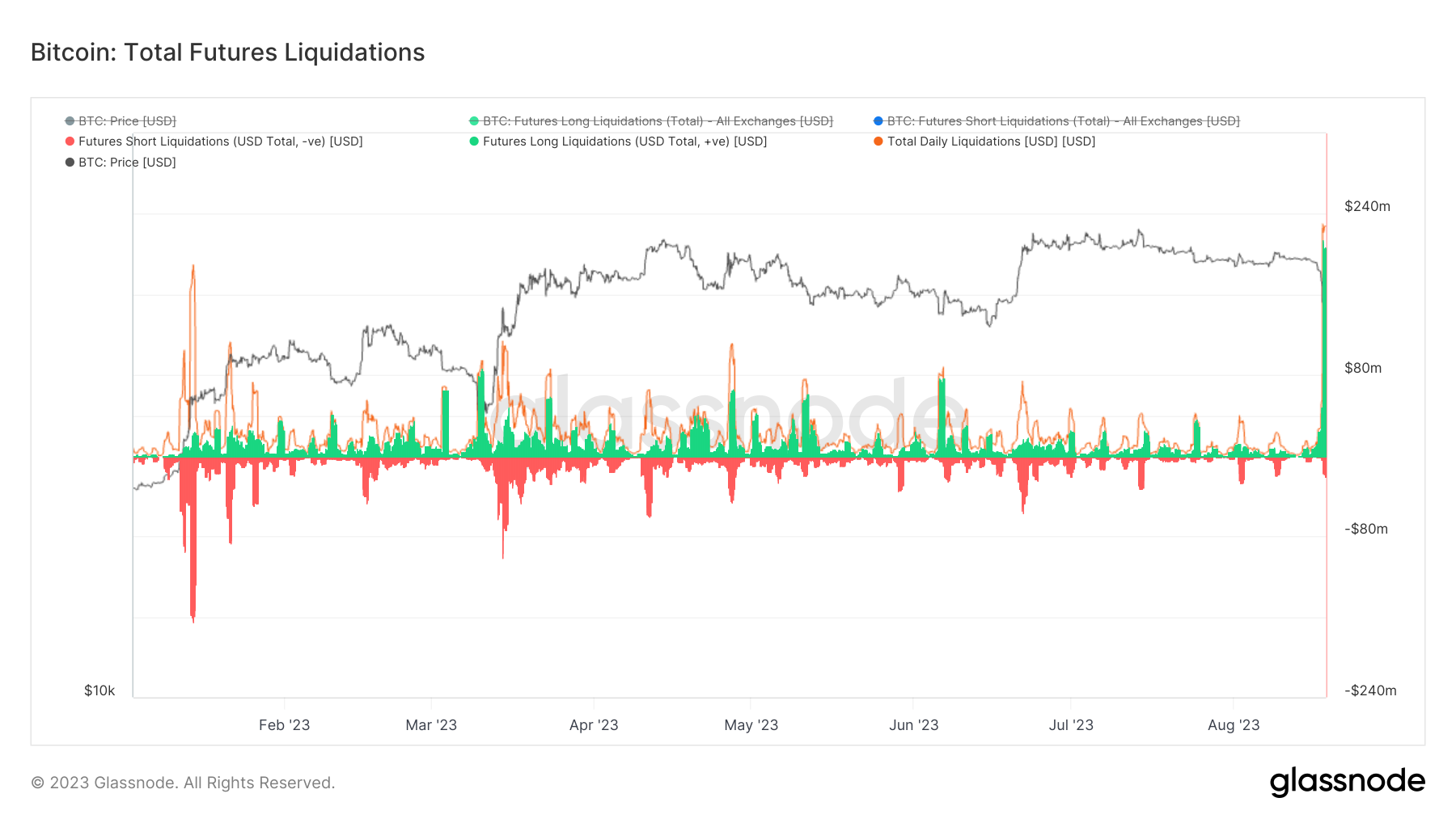
Total Futures Liquidations Metric
To get a handle on these events, metrics like the Total Futures Liquidations metric above comes in handy. This metric comprises:
- Long Liquidations (green): Positions in favor of Bitcoin's price rising that were terminated due to unfavorable price movements.
- Short Liquidations (red): Positions betting against Bitcoin, closed because the price increased.
- Combined Total Liquidations (orange): The sum of both long and short liquidations.
Why Liquidations Matter
Why should you keep an eye on this metric?
- Market Sentiment Insight: High volumes of long liquidations may signify an overly optimistic market, while high volumes of short liquidations could indicate a pessimistic sentiment.
- Volatility Gauge: Spikes in liquidations often correlate with volatile periods in the market, offering traders a quick snapshot of market temperament.
- Risk Management: An uptick in liquidation volumes often suggests that traders might be over-leveraging, presenting a potential for cascading liquidations that could impact the broader market.
In summary, technological advances in Bitcoin futures and the emergence of Bitcoin options contribute to the evolving landscape of crypto derivatives markets. Each instrument presents unique opportunities and risks
Current Options for Trading Bitcoin Futures
After exploring the role and impact of Bitcoin futures and options, along with associated risks and opportunities, the next consideration is where these trades can be executed. The accessibility of Bitcoin futures trading has increased due to a variety of platforms and financial products. The options available to traders fall into four main categories.
Regulated Exchanges:
Beginning in 2017, traditional financial exchanges like CBOE and CME entered the scene, providing a regulated avenue for Bitcoin futures trading. Falling under the stringent oversight of the U.S. Commodity Futures Trading Commission (CFTC), these platforms have become the go-to option for institutional investors seeking reliability and compliance.
Crypto-native Exchanges:
Contrastingly, crypto-native platforms such as Binance and BitMEX offer an alternative flavor. These platforms provide futures contracts that often come with higher leverage and diverse contract specifications. But it's crucial to note that lighter regulatory oversight implies elevated risks.
Futures ETFs:
Further democratizing access to Bitcoin futures trading, the Securities and Exchange Commission (SEC) approved the first Bitcoin futures ETF in 2021. This innovative financial product lets investors speculate on Bitcoin's price movements without owning the actual cryptocurrency.
Brokerage Services:
Traditional brokerage services such as Interactive Brokers and TD Ameritrade have expanded to include Bitcoin futures, diversifying options for traders
To truly get a grasp of the activity level and general sentiment in the futures market, traders often turn to metrics such as Futures Volume. This metric encapsulates the 24-hour trading volume of Bitcoin futures contracts. High volumes often serve as strong indicators of market liquidity and sentiment, providing essential clues about potential price directions and volatility levels.

Practical Strategies for Navigating Bitcoin Futures and Crypto Derivatives
After reviewing platforms for trading Bitcoin futures, the discussion will now focus on strategies for navigating this landscape. A crucial aspect of any trading strategy is risk management, along with the constant monitoring of key metrics such as open interest, as we can see below.
Open interest represents the total number of unsettled derivative contracts, such as futures and options. This metric serves as a barometer for trading activity, market liquidity, and even shifts in investor sentiment. For instance, a rise in open interest often indicates new capital entering the market, signaling strong trader commitment. Conversely, a decline could signify market liquidation and impending volatility.
Looking at 2023 data, open interest in Bitcoin futures surged by 50.89% from January 1st to August 1st. This suggests increased trading activity and potentially greater liquidity in the Bitcoin derivatives market.
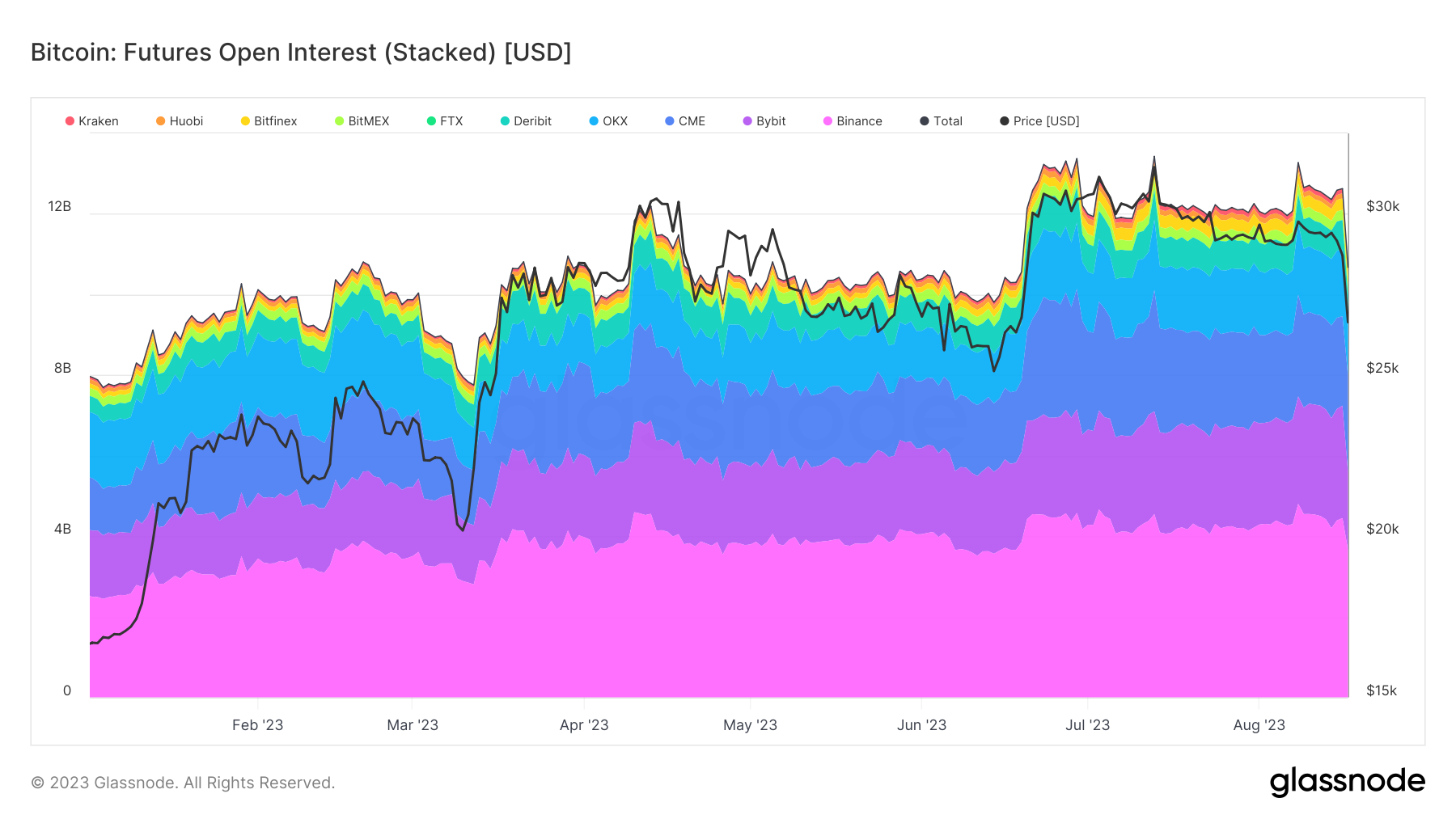
Another lens to view the derivatives market through is the Futures Open Interest (OI) Leverage Ratio and the Perpetual OI Leverage Ratio. For example, on January 2nd, 2023, the Futures OI Leverage Ratio was 2.47%. This implied that every $100 in a trader's margin was backing futures contracts worth $2.47. By August 3rd, these ratios had decreased to 2.13% and 1.62%, even as Bitcoin's price increased.
What's the significance? The declining ratios, against a backdrop of rising Bitcoin prices, could suggest a shrinking size of the derivatives market relative to Bitcoin's overall market cap. This might indicate a reduced risk of market shifts heavily influenced by derivative activity, such as long or short squeezes. However, a sharp drop in these ratios could still act as a precursor to significant market events, like forced liquidations.
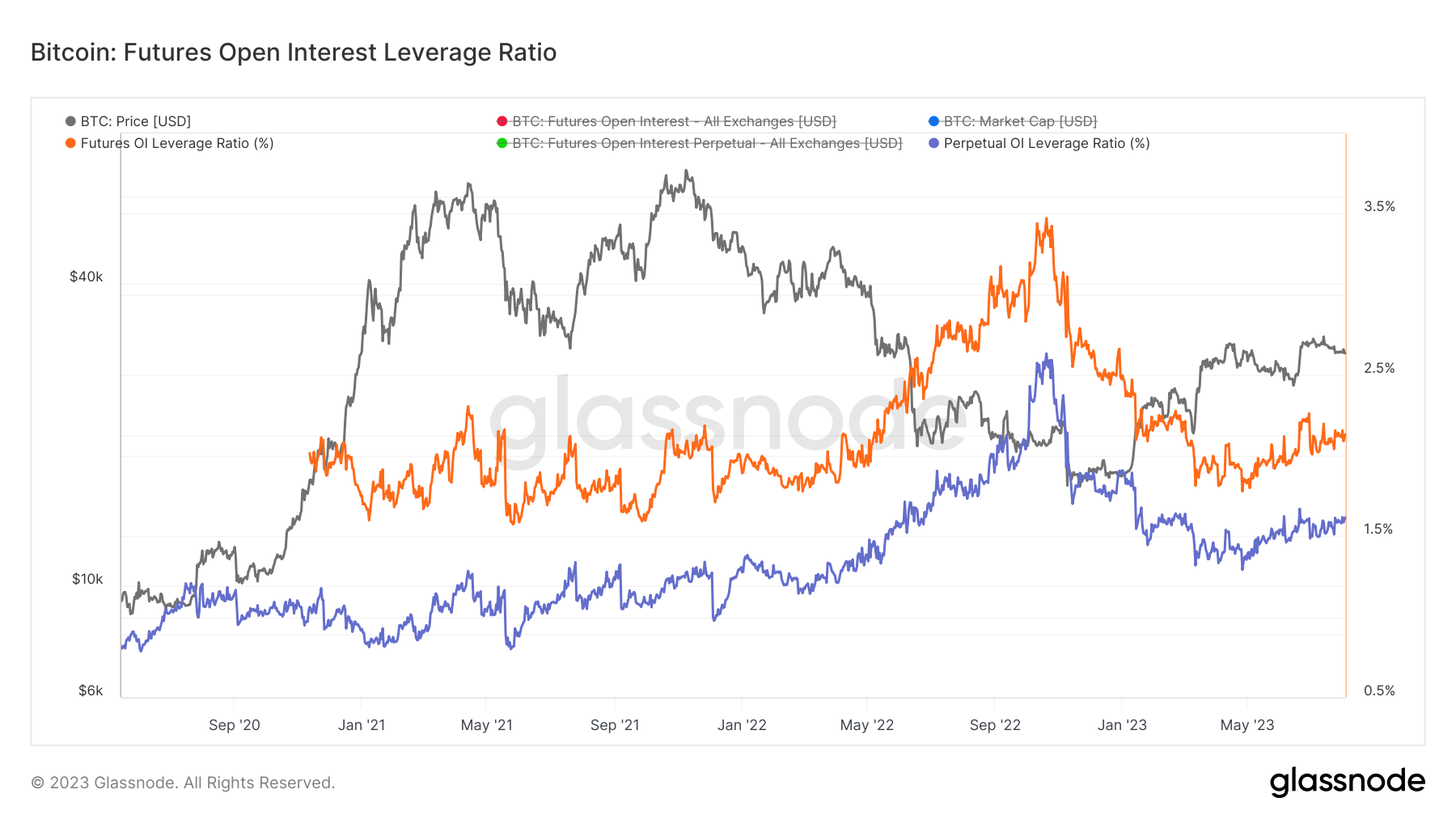
Conclusion
Bitcoin and other cryptocurrencies have come a long way in recent years, reaching a level of maturity that few thought possible just a few years ago. One sign of this maturity is the rise of complex trading mechanisms, such as options and futures. These markets significantly impact the spot price of Bitcoin. For investors looking to navigate these complexities, Glassnode offers a range of tools such as charts, Workbench, and an API.
These resources can help you better understand these markets, thus improving your risk management and investment strategies.
Disclaimer:Past performance is not indicative of future results. This article is intended for informational purposes only, and it does not constitute investment advice. Always conduct thorough research.